Hydrodynamic Model Optimization for Marine Tourism Development Suitability in Vicinity of Poso Regency Coastal Area, Central Sulawesi, Indonesia
Abstract
:1. Introduction
2. Materials and Methods
2.1. Hydrodynamic Model Using Delft3D
- H(t) = Water level at time t
- Ao = Mean water level over a certain period
- k = Number of relevant constituents
- i = Index of a constituent
- Ai = Local tidal amplitude of a constituent
- Fi = Nodal amplitude factor
- ωi = Angular velocity
- (Vo + u) = Astronomical argument
- Gi = Improved kappa number (=local phase lag)
- x, y, z = Coordinates
- u, v, w = Speed components
- ρ = Density
2.2. Root Mean Square Error (RMSE)
- Predictedi = Predicted value data
- Actuali = Actual simulation
- N = Number of data
2.3. Analysis Hierarchy Process (AHP)
3. Results
3.1. Model Simulation Using Delft3D
3.2. Validation and Verification of Simulated Hydrodynamic Model
3.3. Coastal Area Development Mapping with ArcGIS
4. Discussion
5. Conclusions
Author Contributions
Funding
Conflicts of Interest
References
- Boteler, B. Coastal Zones: Achieving Sustainable Management—Guest editorial. Sci. Environ. Policy 2014, 2014, 4–5. [Google Scholar]
- Tonazzini, D.; Fosse, J.; Morales, E.; González, A.; Klarwein, S.; Moukaddem, K.; Louveau, O. Blue Tourism: Towards a Sustainable Coastal and Maritime Tourism in World Marine Regions; Eco-union: Barcelona, Spain, 2019; Available online: https://www.ecounion.eu (accessed on 8 March 2020).
- Hengky, S.H. Challenges sustainable coastal tourism on Panjang Island. J. Aquac. Marine Biol. 2019, 8, 180–184. [Google Scholar]
- UNEP. Sustainable Coastal Tourism: An Integrated Planning and Management Approach; UNEP Publication: Cedex, France, 2009; Available online: https://wedocs.unep.org/20.500.11822/7819 (accessed on 20 May 2022).
- Sukmayeti, E. A Social Mapping of Fishermen Resource and Accessibility for Coastal Tourism Development Policy. Society 2019, 7, 116–134. [Google Scholar] [CrossRef]
- Kurniawan, F.; Adrianto, L.; Bengen, D.G.; Prasetyo, L.B. Vulnerability assessment of small islands to tourism: The case of the Marine Tourism Park of the Gili Matra Islands, Indonesia. Glob. Ecol. Conserv. 2016, 6, 308–326. [Google Scholar] [CrossRef]
- Dwyer, L. Emerging Ocean Industries: Implications for sustainable tourism development. Tourism Marine Environ. 2018, 13, 25–40. [Google Scholar] [CrossRef]
- UNWTO and UNDP. Tourism, and the Sustainable Development Goals—Journey to 2030; UNWTO Publication: Madrid, Spain, 2017; Available online: https://www.e-unwto.org/doi/book/10.18111/9789284419401 (accessed on 25 June 2022).
- Ahmad, F.; Draz, M.U.; Su, L.; Rauf, A. Taking the bad with the good: The nexus between tourism and environmental degradation in the lower middle-income Southeast Asian economies. J. Clean. Prod. 2019, 233, 1240–1249. [Google Scholar] [CrossRef]
- Sutawa, G.K. Issues on Bali Tourism Development and Community Empowerment to Support Sustainable Tourism Development. Procedia Econ. Financ. 2012, 4, 413–422. [Google Scholar] [CrossRef]
- Toursim Office of Central Sulawesi. Analisa Data Kunjungan Wisatawan Sulawesi Tengah Tahun 2020. Central Sulawesi Province. 2021. Available online: https://drive.google.com/file/d/1bU2LPZB17uuohtmI8xw6v6WJRcRS7IWl/view (accessed on 28 December 2022).
- Balingki, A. Strategi Pengembangan Wisata Di Pesisir Danau Poso Kecamatan Pamona Puselemba Kabupaten Poso. Katalogis 2015, 3, 181–193. [Google Scholar]
- Rembang, C.M.P.; Kimbal, M.; Lengkong, J. Implementasi Program Pengembangan Kawasan Pariwisata Danau Poso oleh Pemerintah Daerah. J. Jur. Ilmu Pemerintah. 2017, 2, 1–9. [Google Scholar]
- Abidjulu, R.T.W. Strategi Pengembangan Pengelolaan Pariwisata Air Terjun Waru Saluopa di Kabupaten Poso. e-J. Kat. 2015, 3, 1–12. [Google Scholar]
- Muqsith, A. Valuasi ekonomi sumberdaya alam pantai sidem. J. Ilmu Perikan. 2015, 6, 135–142. [Google Scholar]
- Girault, V.; Raviart, P.A. Finite Element Approximation of the Navier-Stokes Equations; Lecture Notes in Mathematics; Springer: Berlin/Heidelberg, Germany, 1979; p. 749. [Google Scholar]
- Chai, T.; Draxler, R.R. Root mean square error (RMSE) or mean absolute error (MAE)? Arguments against avoiding RMSE in the literature. Geosci. Model Dev. 2014, 7, 1247–1250. [Google Scholar] [CrossRef]
- Fahmi, M.; Hafli, T.M. Simulasi Numerik Perubahan Morfologi Pantai Akibat Konstruksi Jetty pada Muara Lambada Lhok Aceh Besar Menggunakan Software Delft3D. J. Tek. Sipil 2019, 8, 50–59. [Google Scholar] [CrossRef]
- Savage, N.H.; Agnew, P.; Davis, L.S.; Ordóñez, C.; Thorpe, R.; Johnson, C.E.; O’Connor, F.M.; Dalvi, M. Air Quality Modelling using the Met Office Unified Model (AQUM OS24-26): Model description and initial evaluation. Geosci. Model Dev. 2013, 6, 353–372. [Google Scholar] [CrossRef]
- Windupranata, W. Development of a Decision Support System for Sustainability Assessment of Mariculture Site Selection. Ph.D. Thesis, Christian Albrechts Universitat zu Kiel, Kiel, Germany, 2007; p. 125. [Google Scholar]
- Williams, J.J.; Esteves, L.S. Guidance on Setup, Calibration, and Validation of Hydrodynamic, Wave, and Sediment Models for Shelf Seas and Estuaries. Adv. Civil Eng. 2017, 2017, 5251902. [Google Scholar] [CrossRef]
- Fredinan, J.; Handoko, A.S. Kajian Karakterisitik Tipologi Pantai untuk Pengembangan Rekreasi Pantai di Suka Alam Perairan Selat Pantar Kabupaten Alor. J. Penelit. Perikan. Laut 2018, 1, 199–209. [Google Scholar]
- Yulianda, F.; Fahrudin, A.; Hutabarat, A.A.; Harteti, S.; Kusharjani, K.H. Pengelolaan Pesisir dan Laut Secara Terpadu; Pusdiklat Kehutanan-Departemen Kehutanan RI-SECEM-Korea International Coorporation Agency: Bogor, Indonesia, 2010; Book 3. [Google Scholar]
- Yulianda, F. Ekowisata Bahari Sebagai Alternative Pemanfaatan Sumberdaya Pesisir Berbasis Konservasi; Seminar Sains Departemen Manajemen Sumberdaya Perairan; Institut Pertanian Bogor: Bogor, Indonesia, 2007. [Google Scholar]
- Jimmy, M.T.; Sutrisno, A.; Hartuti, P. Kajian Kualitas Lingkungan dan Kesesuaian Wisata Pantai Tanjung Peson Kabupaten Bangka; Prosiding Seminar Nasional Pengelolaan Sumberdaya Alam dan Lingkungan; Universitas Diponegoro: Semarang, Indonesia, 2013. [Google Scholar]

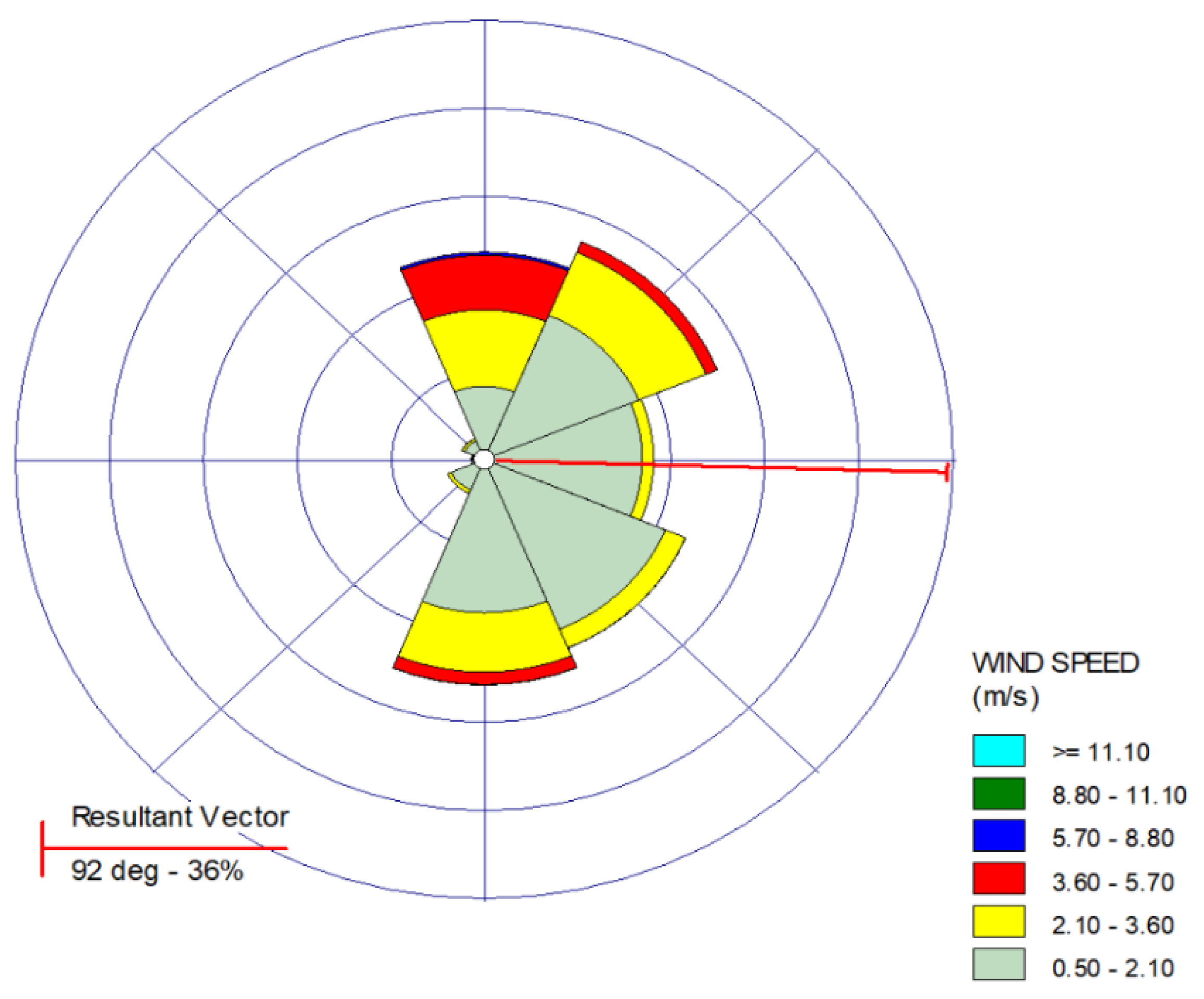
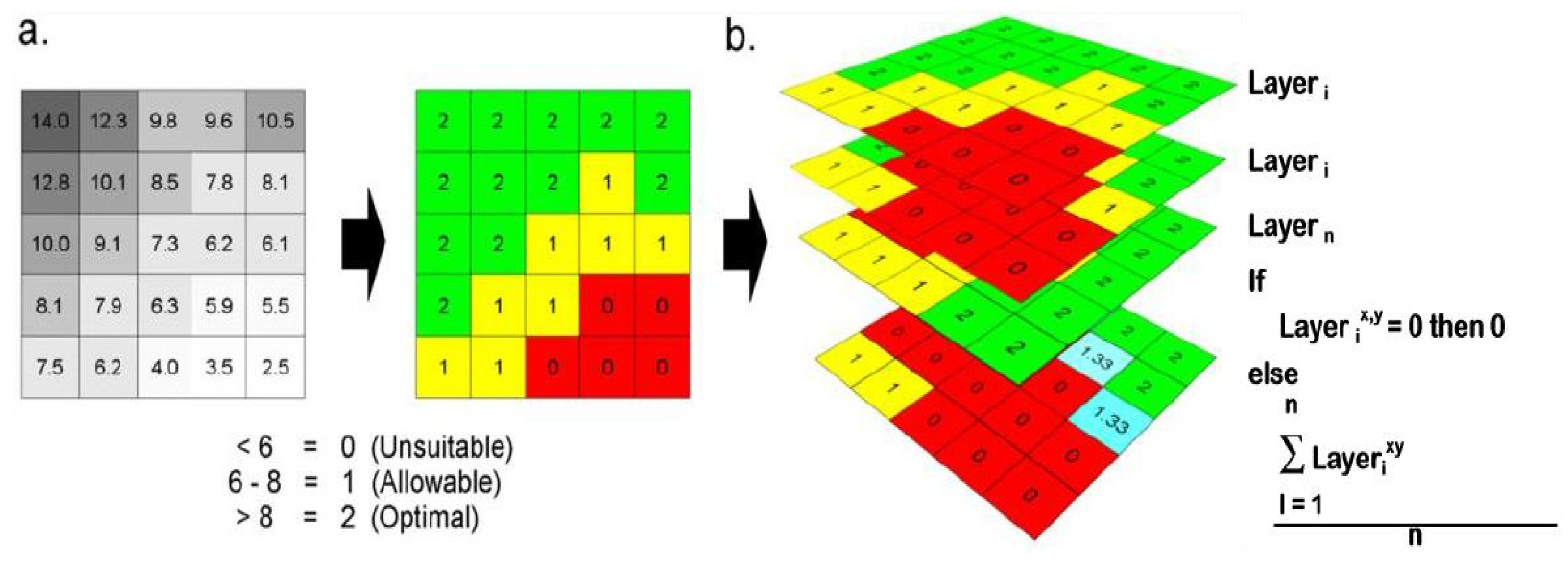
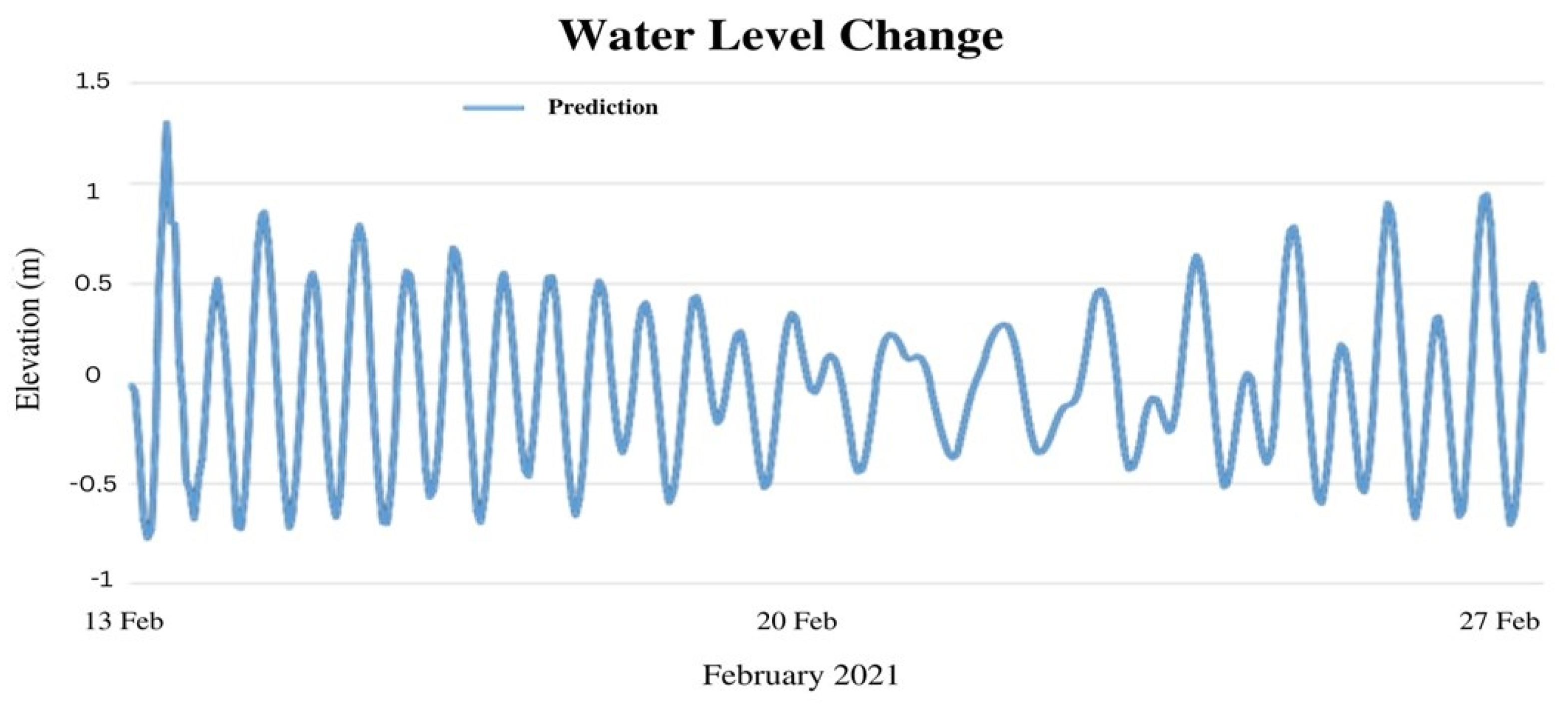
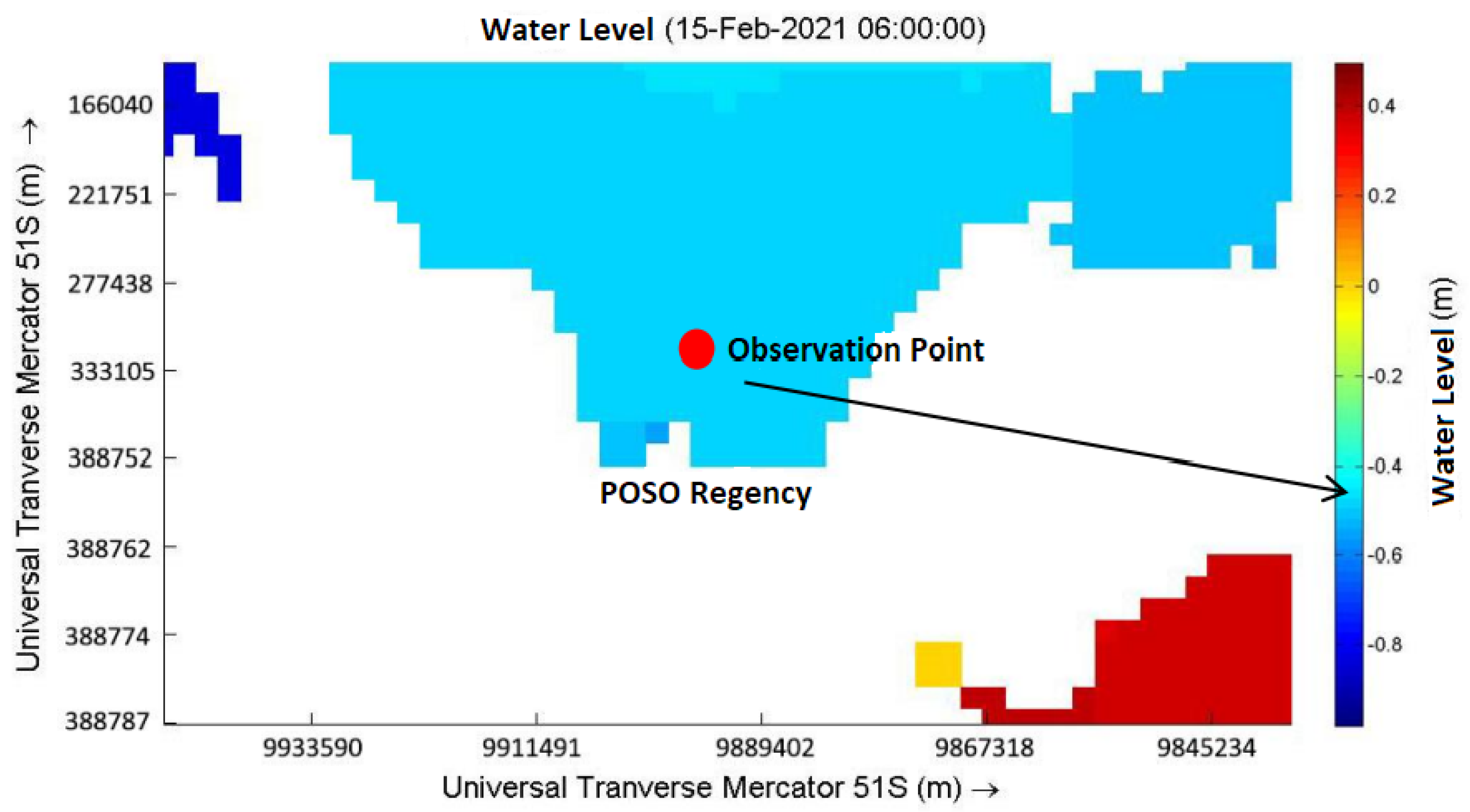

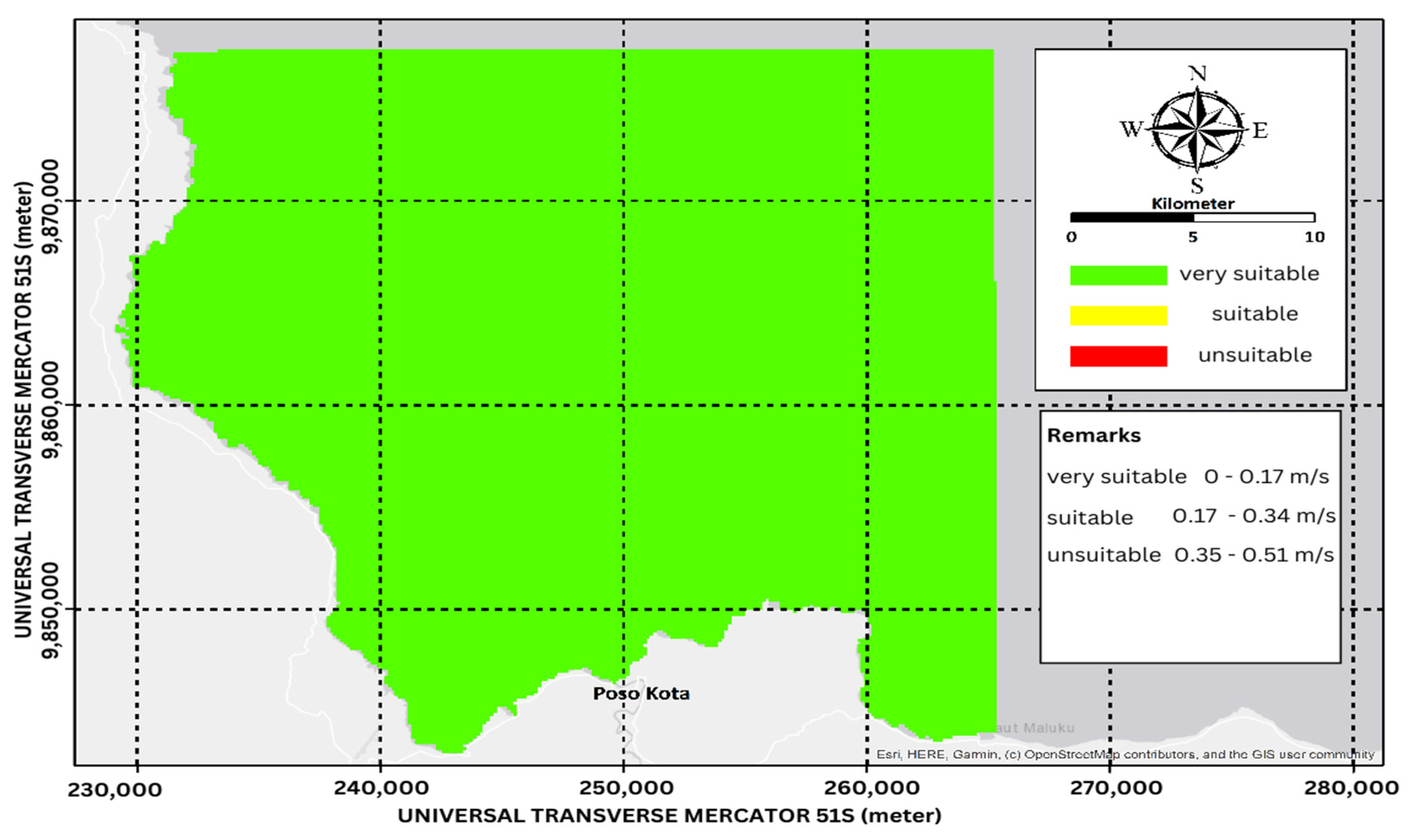
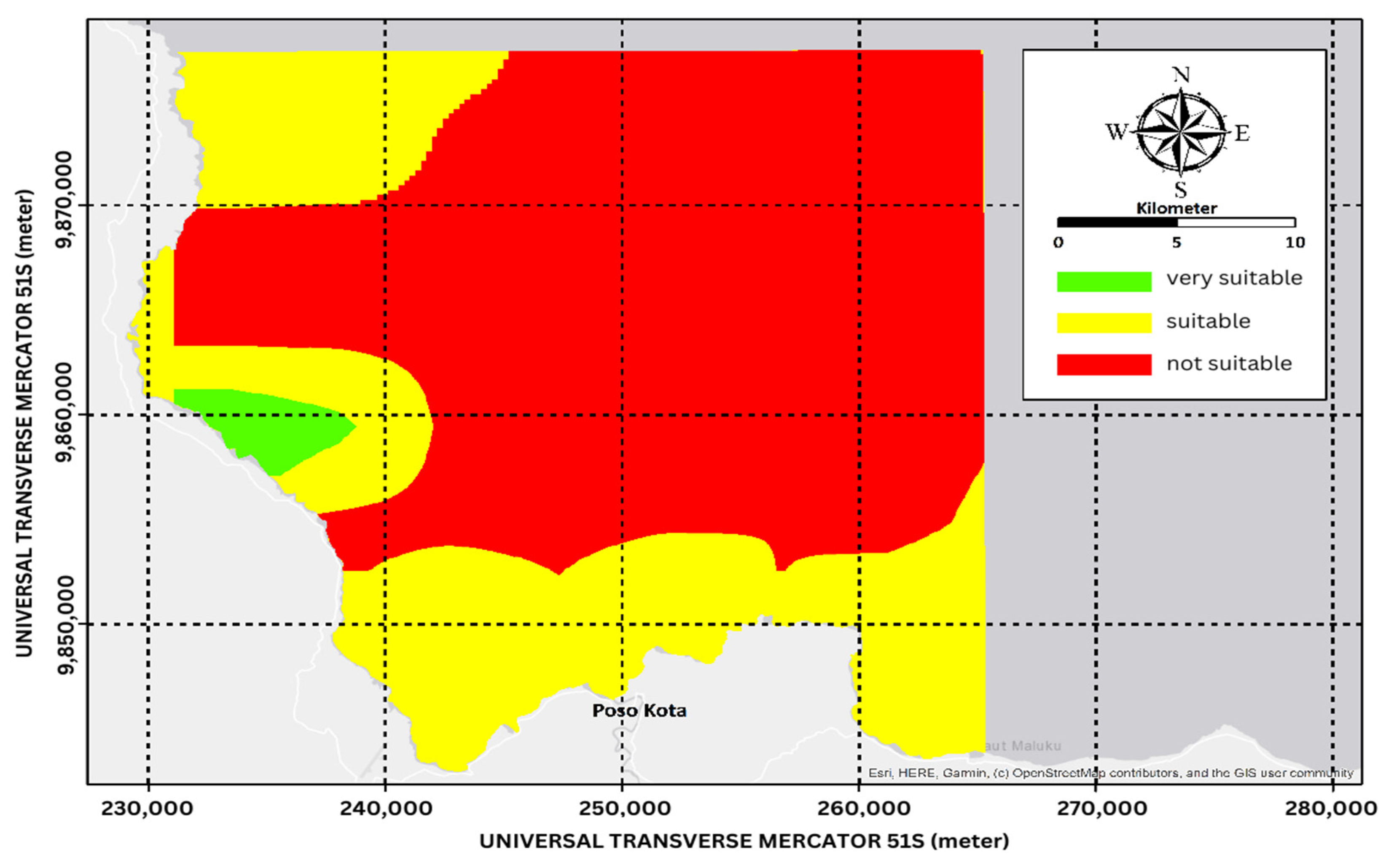
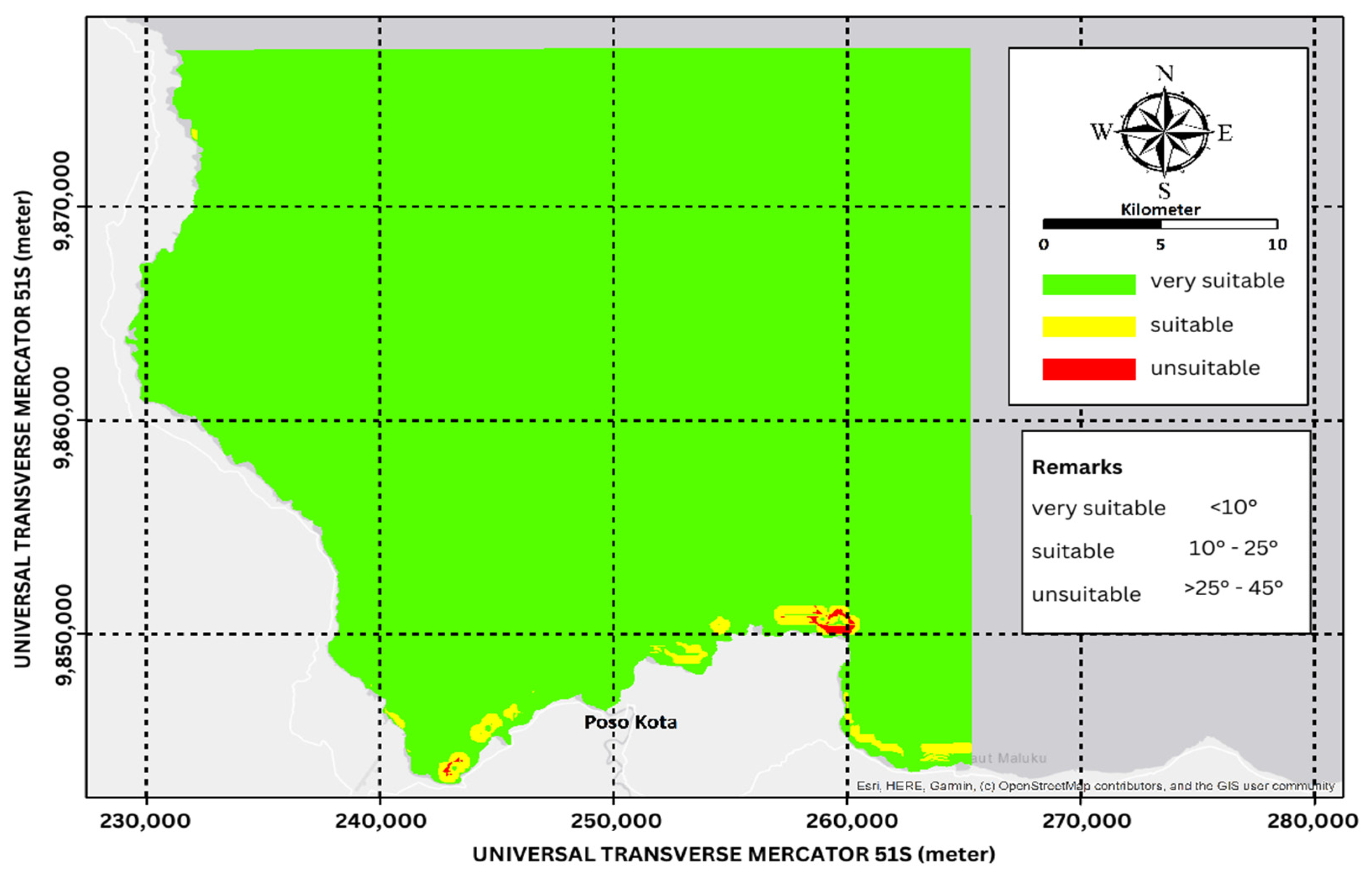
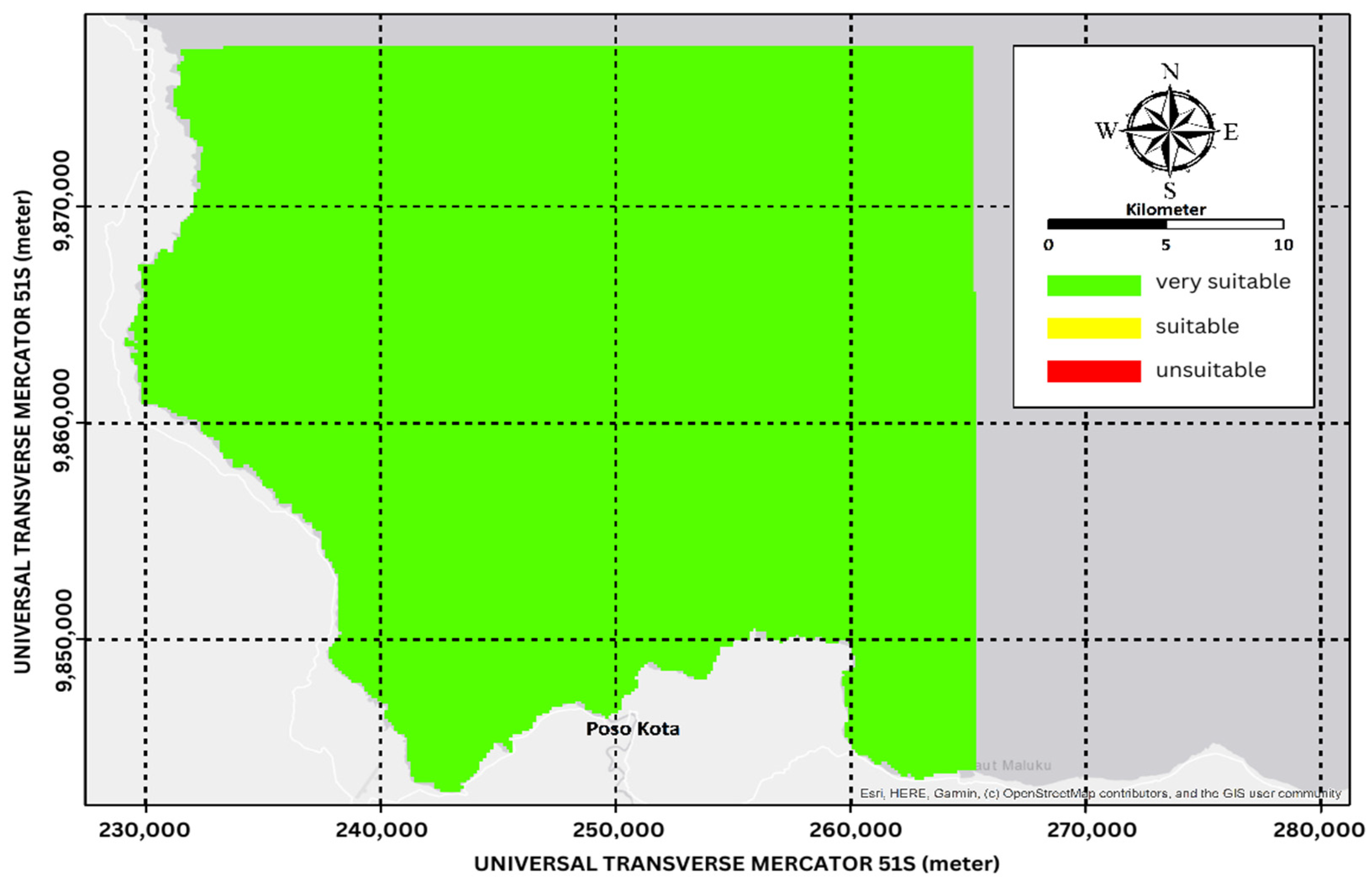

| No. | Model | Grid (Meter) | Bathymetry | Manning’s Roughness | Time Step (Minutes) | Simulation Duration (Days) | Desc. |
|---|---|---|---|---|---|---|---|
| 1 | A | 200 | GEBCO | 0.05 | 60 | 365 | Failed |
| 2 | B | 1200 | GEBCO | 0.05 | 60 | 365 | Failed |
| 3 | C | 1600 | GEBCO | 0.05 | 5 | 30 | Failed |
| 30 | |||||||
| 60 | |||||||
| 4 | D | 5550 | GEBCO | 0.05 | 5 | 14 | Successful |
| 30 | |||||||
| 60 | |||||||
| 5 | E | 5550 | GEBCO | 0.05 | 5 | 14 | Successful |
| 0.033 | |||||||
| 0.025 |
| POSO | Jumlah Data (n) | 360 | |
|---|---|---|---|
| Dote and Time | Predicted (m) | Actual (m) | (Predicted − Actual)^2 |
| 2021-02-13 01:00:00, | −0.00660431 | −0.266 | 0.067286124 |
| 2021-02-13 02:00:00, | −0.0402799 | −0.42 | 0.144187354 |
| 2021-02-13 03:00:00, | −0.308369 | −0.489 | 0.032627558 |
| 2021-02-13 04:00:00, | −0.667691 | −0.446 | 0.049146899 |
| 2021-02-13 05:00:00, | −0.772871 | −0.29 | 0.233164403 |
| 2021-02-13 06:00:00, | −0.727247 | −0.051 | 0.457310005 |
| 2021-02-13 07:00:00, | −0.240389 | 0.221 | 0.212879809 |
| 2021-02-13 08:00:00, | 0.439049 | 0.464 | 0.000622552 |
| 2021-02-13 09:00:00, | 0..86659 | 0.623 | 0.059336088 |
| 2021-02-13 10:00:00, | 1.30275 | 0.661 | 0.411843063 |
| 2021-02-13 11:00:00, | 0.80441 | 0.57 | 0.054948048 |
| 2021-02-13 12:00:00, | 0.796764 | 0.374 | 0.1787294 |
| 2071-07-13 13:00:00, | 0.123352 | 0.12 | 1.12359 × 10−5 |
| 2021-02-13 14:00:00, | −0.11178 | −0.132 | 0.000408848 |
| 2021-02-27 19:00:00, | −0.127693 | 0.054 | 0.033012346 |
| 2021-02-27 20:00:00, | 0.206054 | 0.22 | 0.000194491 |
| 2021-02-27 21:00:00, | 0.430109 | 0.306 | 0.015403044 |
| 2021-02-27 22:00:00, | 0.499308 | 0.285 | 0.045927919 |
| 2021-02-27 23:00:00, | 0.401124 | 0.159 | 0.058624031 |
| 2021-02-28 00:00:00, | 0.166415 | −0.038 | 0.041785492 |
| TOTAL (∑) | 12.249 | ||
| The Root Mean Square Error (RMSE) | 0.184 | ||
| Parameter | Unit | Very Suitable | Suitable | Unsuitable |
|---|---|---|---|---|
| Water depth | m | 0–3 | >3–6 | >6–10 |
| Type of coast | White sand | White sand with coral | Black sand, coral, and stiff | |
| Wide of coast | m | >15 | <10–15 | 3–9 |
| Bed coast material | Sand | Sandy coral | Sandy mud | |
| Current speed | m/s | 0–0.17 | 0.17–0.34 | 0.34–0.51 |
| Coastal slope | o | <10 | 10–25 | >25–45 |
| Water clarity | % | >10 | >5–10 | 3–5 |
| Coastal closing area | Coconut tree, open area | Scrubs, lowland, savanna | High scrubs | |
| Dangerous biota | No | Jellyfish, sea urchin | Nani’s fur, stingray | |
| Freshwater | Km | <0.5 | >0.5–1 | >1–2 |
Disclaimer/Publisher’s Note: The statements, opinions and data contained in all publications are solely those of the individual author(s) and contributor(s) and not of MDPI and/or the editor(s). MDPI and/or the editor(s) disclaim responsibility for any injury to people or property resulting from any ideas, methods, instructions or products referred to in the content. |
© 2023 by the authors. Licensee MDPI, Basel, Switzerland. This article is an open access article distributed under the terms and conditions of the Creative Commons Attribution (CC BY) license (https://creativecommons.org/licenses/by/4.0/).
Share and Cite
Hermawan, S.; Mihardja, E.; Pambudi, D.A.; Jason, J. Hydrodynamic Model Optimization for Marine Tourism Development Suitability in Vicinity of Poso Regency Coastal Area, Central Sulawesi, Indonesia. Sustainability 2023, 15, 3150. https://doi.org/10.3390/su15043150
Hermawan S, Mihardja E, Pambudi DA, Jason J. Hydrodynamic Model Optimization for Marine Tourism Development Suitability in Vicinity of Poso Regency Coastal Area, Central Sulawesi, Indonesia. Sustainability. 2023; 15(4):3150. https://doi.org/10.3390/su15043150
Chicago/Turabian StyleHermawan, Surya, Edwin Mihardja, Devian Aryo Pambudi, and Jason Jason. 2023. "Hydrodynamic Model Optimization for Marine Tourism Development Suitability in Vicinity of Poso Regency Coastal Area, Central Sulawesi, Indonesia" Sustainability 15, no. 4: 3150. https://doi.org/10.3390/su15043150




